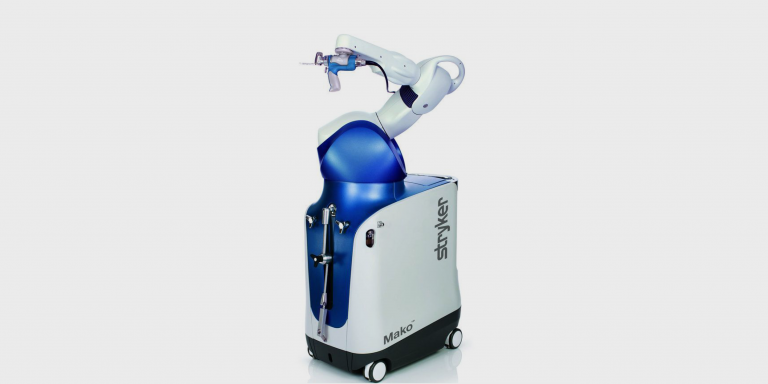
The Hospices Civils de Lyon are experts in knee and hip surgery, fitting more than 3,000 prostheses each year. To optimize and secure these operations, the orthopedic surgery departments of the Hospices Civils de Lyon have benefited from an additional technological innovation with the arrival of the Mako® surgical robot from the Stryker company. This assisted surgery system has made it possible to install dozens of knee and hip prostheses every month. The acquisition of the Mako® robot is in line with the University Hospital’s policy of making robotic surgery an area of excellence, and thus enabling the HCL orthopedic surgery departments to maintain their leadership.
Since the 1990s, robotic systems have continued to progress. They improve the precision of the surgical gesture and its reproducibility. Interventions are less invasive, less traumatic, and preserve the musculature around the joints. Last February, the HCL received a latest generation system. The use of this robotic system will be shared between the orthopedic surgery departments of the Croix-Rousse and Lyon Sud hospitals.
Mako®, a high-performance assistant thanks to the latest generation of robotics
Whatever the brand, material and model of joint prosthesis chosen by a surgeon, the quality of the fitting is essential. A 3D study based on CT scans, surgical navigation, and customized cutting guides improve the procedure, but the Mako® robot corrects any inaccuracies.
Mako® is a semi-active robot initially developed for the implantation of partial knee prostheses. It is now also used for total hip and knee replacements. It offers new personalized approaches and provides a considerable technical advance for the benefit of patients and healthcare professionals.
In practice, from the patient’s scan, the software associated with the robotic system creates a 3D anatomical model and its modeling after virtual implantation of the prosthetic components under permanent control of a navigation system and the surgeon. The surgeon can therefore visualize the patient’s anatomy, choose the best surgical strategy and then direct the robot during the operation. Each operation is thus personalized.
Dr. Anthony Viste, deputy head of the orthopedic surgery department at Lyon Sud Hospital, explains:
“The robot will follow, to the letter, the surgeon’s indications and thus make the gesture more precise in order to improve the survival of prosthetic implants and patient satisfaction.”
Course of the operation
The surgeon keeps control of each of the gestures and performs the operation himself. The first step of the procedure consists of adjusting the 3D planning made with sensors that take into account the ligaments and the patient’s range of motion, thus allowing the precision of the gesture to be adjusted. Once the adjustments are made, the robot performs the bone cuts guided by the surgeon and according to the patient’s personalized 3D model.
The ultra-precise robotic system reduces risks and optimizes the surgical procedure, since the robot’s arm, held by the surgeon, prevents going beyond the defined perimeter: all the elements surrounding the bone are protected. Implant size and bone resections can be adjusted during the procedure using the navigation system.
Management of the most complex cases and improved post-operative recovery
Thanks to the precision provided by the Mako® robot, this surgery is less traumatic for the patient and less painful. The patient’s recovery after surgery is faster, which reduces the length of hospitalization and allows for outpatient care.
This technology also makes it possible to improve the surgical management of the most complex cases, with congenital anomalies or severe deformities, “while fulfilling an essential educational function in a university hospital, a place of research and teaching,” concludes Prof. Lustig, head of the orthopedic surgery and sports medicine department at the Croix-Rousse hospital.
The interest of robotics extends to the collection of factual data. When digested by artificial intelligence, this data can be used to advance research. ” We will be able, for example, to compare the effectiveness of prostheses with or without cement ,” the specialists explain.
Hospices Civils de Lyon, France’s second largest university hospital, considers innovation to be a key factor in quality, motivation and attractiveness, and is developing an ambitious program to support innovation in health care, in all its forms, including the creation of a dedicated department to accelerate the identification and implementation of innovative projects, and an internal call for projects with an annual budget of €2.5M.
The acquisition of the Mako® robot is fully in line with this ambitious strategy for the development of innovation at HCL, and more specifically for innovation in robotic surgery, which is a structuring and particularly mobilizing axis for the entire hospital community and for patients.
Translated from Robotique : les chirurgiens orthopédistes des HCL sont assistés par le bras robotisé de Mako®









